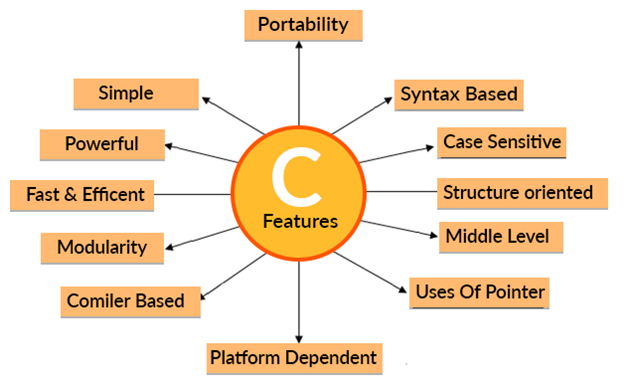C is a widely used and influential programming language that has played a significant role in the history of computer programming. Here's an overview of the history and key features of the C programming language:
**History:**
- C was developed in the early 1970s by Dennis Ritchie at Bell Labs (AT&T's Bell Telephone Laboratories) in the United States. It evolved from an earlier language called B, which was created by Ken Thompson.
- The development of C was closely tied to the development of the Unix operating system, which was also created at Bell Labs. C became the primary language for Unix development.
- The first official C compiler, known as "C Version 1" (K&R C), was released in 1972. The language underwent further development and standardization.
- In 1978, the first edition of "The C Programming Language" (often referred to as "K&R C") by Brian Kernighan and Dennis Ritchie was published. This book became a seminal reference for C programmers.
**Key Features:**
1. **Portability:** C was designed to be a portable language, allowing programs written in C to be easily moved to different computer systems without major modifications. This was achieved by separating C from machine-specific details through the use of a compiler.
2. **Efficiency:** C provides low-level access to memory and hardware resources, which allows for fine-grained control and optimization of code. It's often used for system programming and developing high-performance applications.
3. **Structured Programming:** C supports structured programming principles, including functions and control flow structures (if, while, for, etc.), making it easier to write organized and maintainable code.
4. **Extensibility:** C allows programmers to create their own functions and data types, promoting code reuse and modularity.
5. **Wide Range of Applications:** Over the years, C has been used for a broad spectrum of applications, including operating systems, embedded systems, games, scientific computing, databases, and more.
**Standardization:**
- The first standardized version of the C language, known as ANSI C or C89 (based on the ANSI C standard published in 1989), provided a common reference for C developers and compilers.
- Subsequent versions, such as C99 and C11, introduced additional features and improvements to the language.
- The C Standard Library, which includes functions like printf() and scanf(), is an essential part of C and is standardized along with the language itself.
**Influence:**
- C has had a profound impact on the development of programming languages. Many modern languages, including C++, C#, Java, and Python, have been influenced by C in terms of syntax, control structures, and memory management.
**Legacy:**
- Despite the emergence of newer programming languages, C remains a crucial language in various domains. It is often used for system-level programming, embedded systems, and when performance is critical.
- The C programming language continues to evolve, with new standards and extensions being developed to address modern programming needs while preserving its core principles of efficiency and portability.
In summary, C is a historically significant programming language known for its portability, efficiency, and widespread influence on the field of computer programming. It continues to be an essential tool for developers across various industries and applications.
Tags:
clanguage

